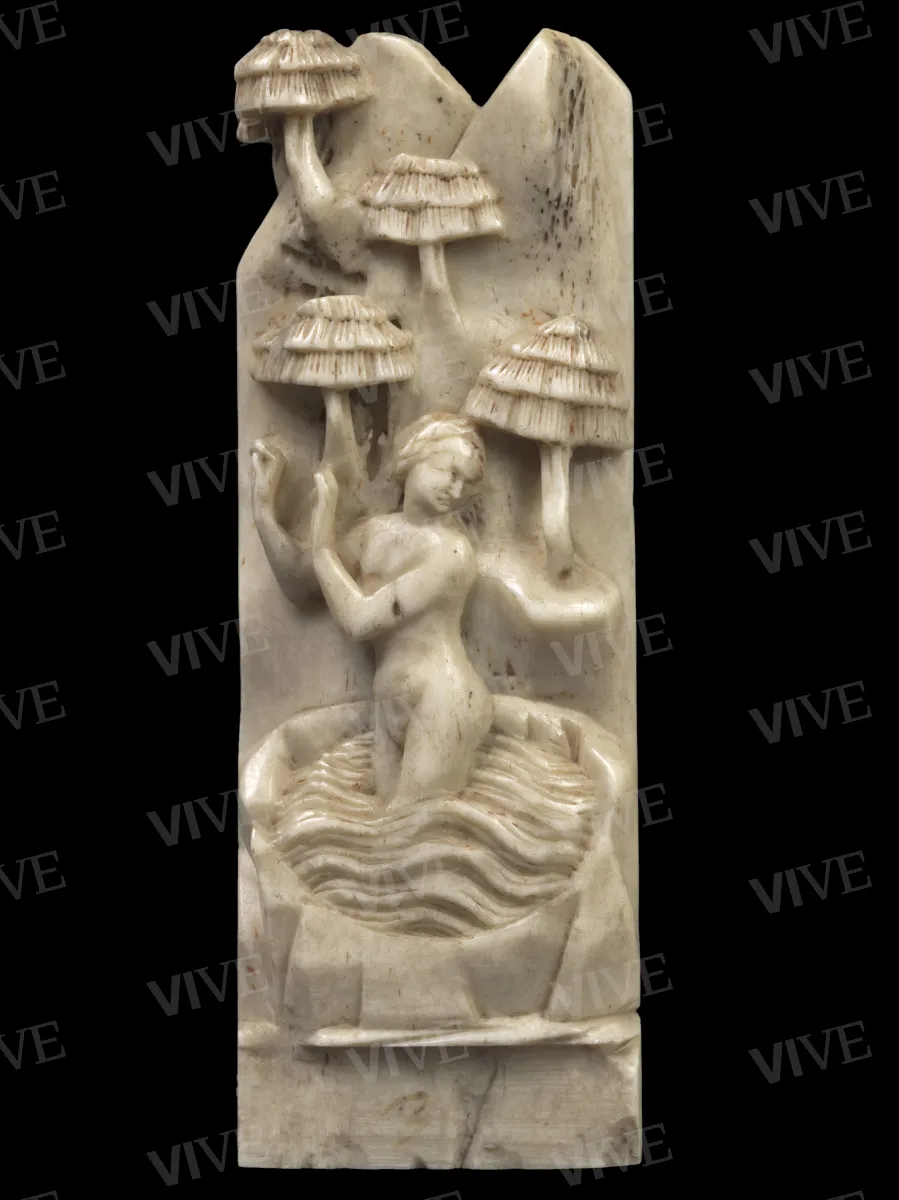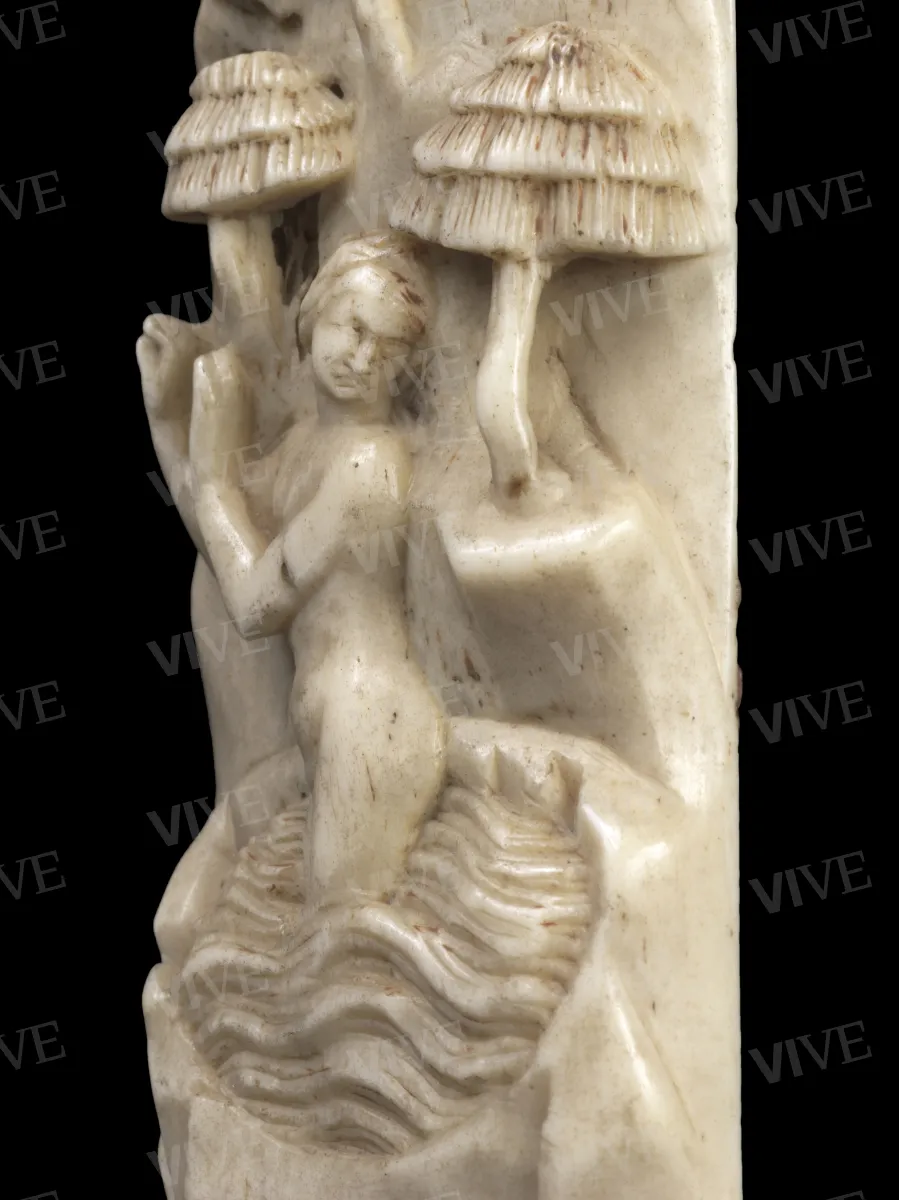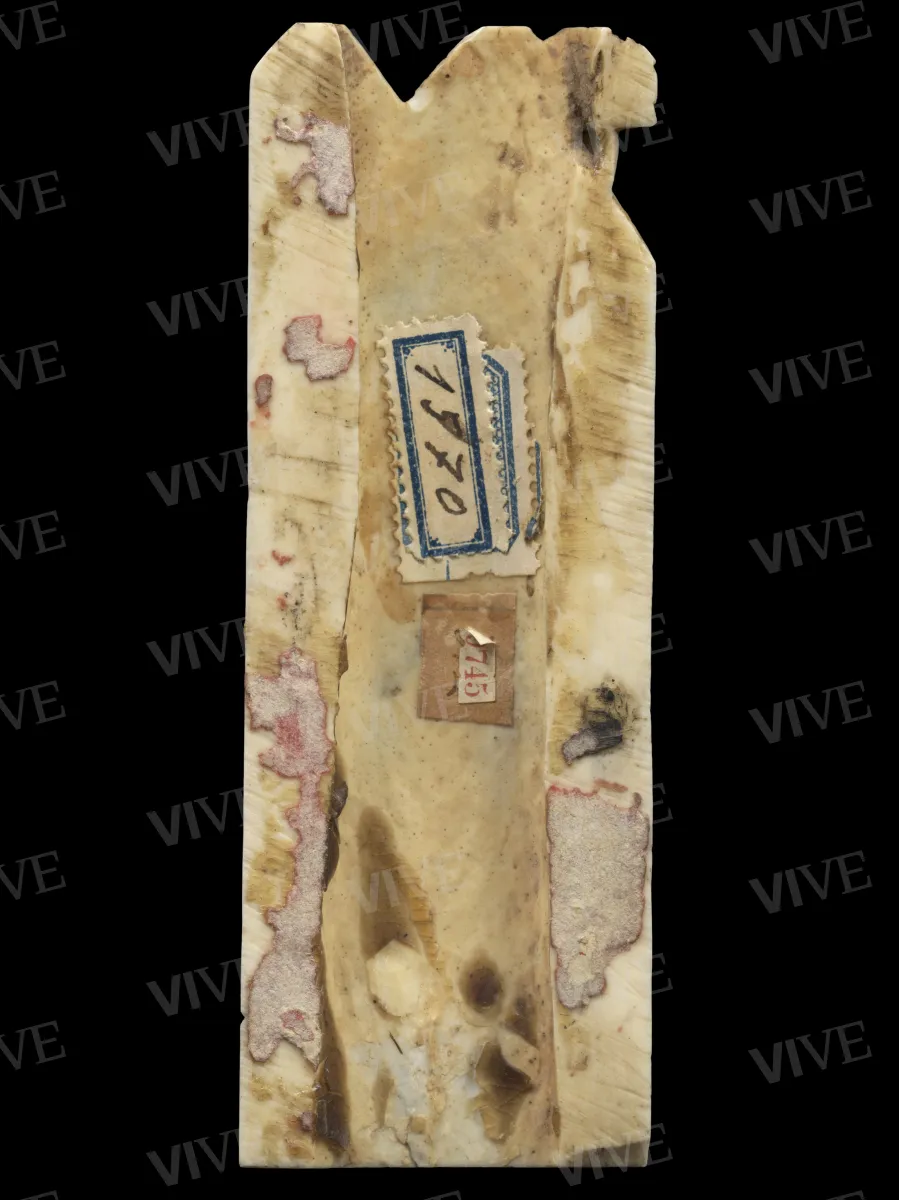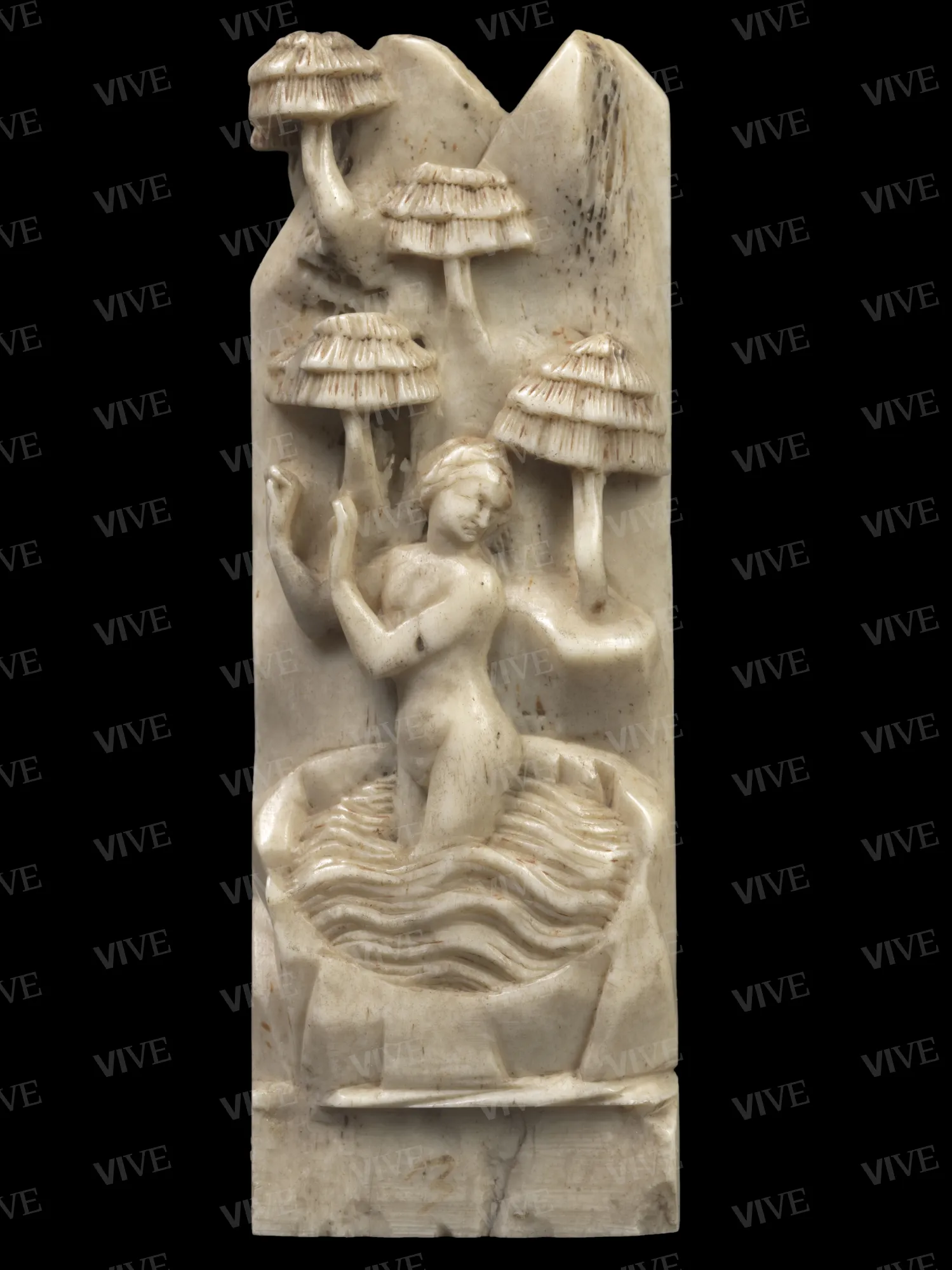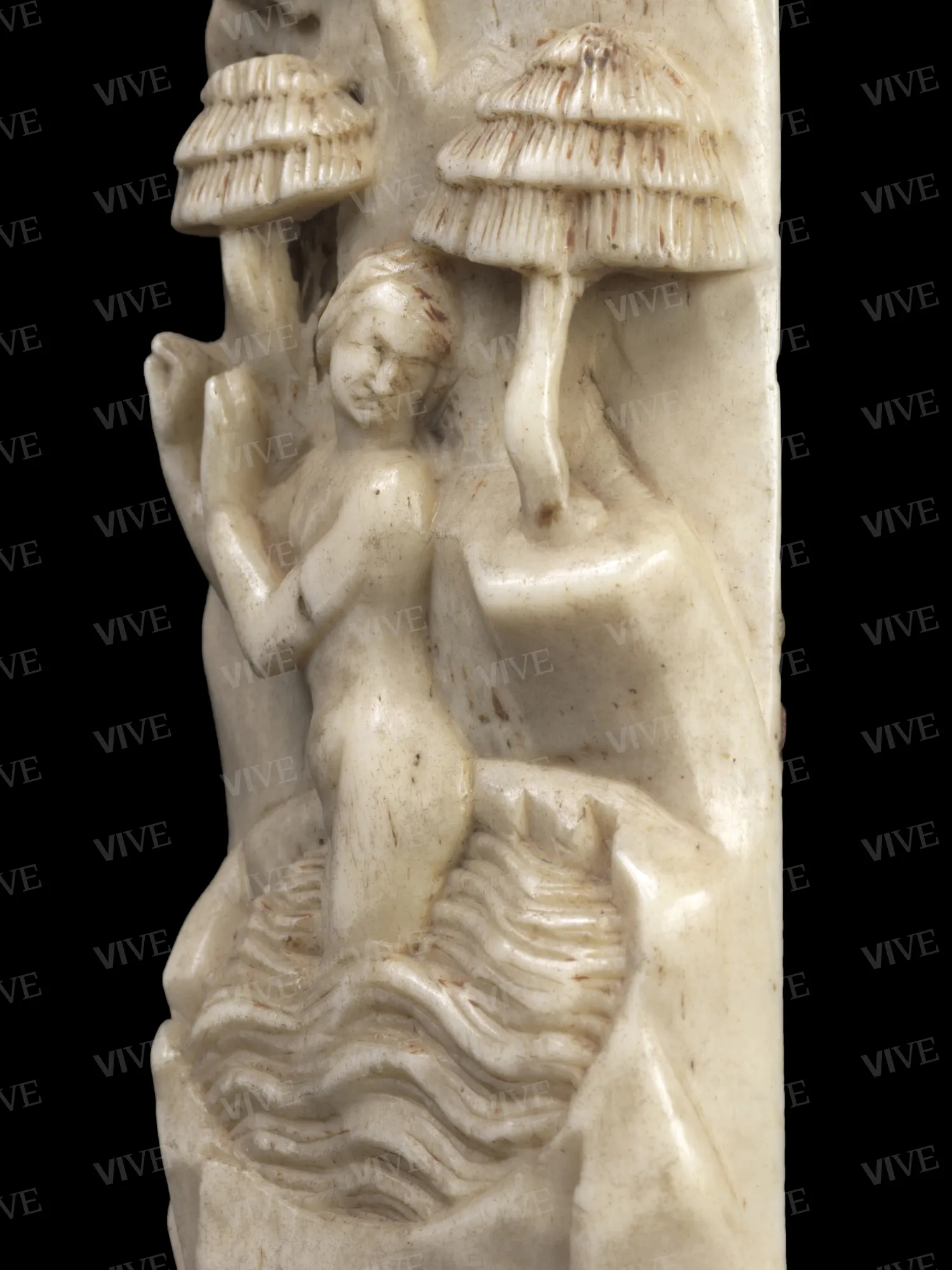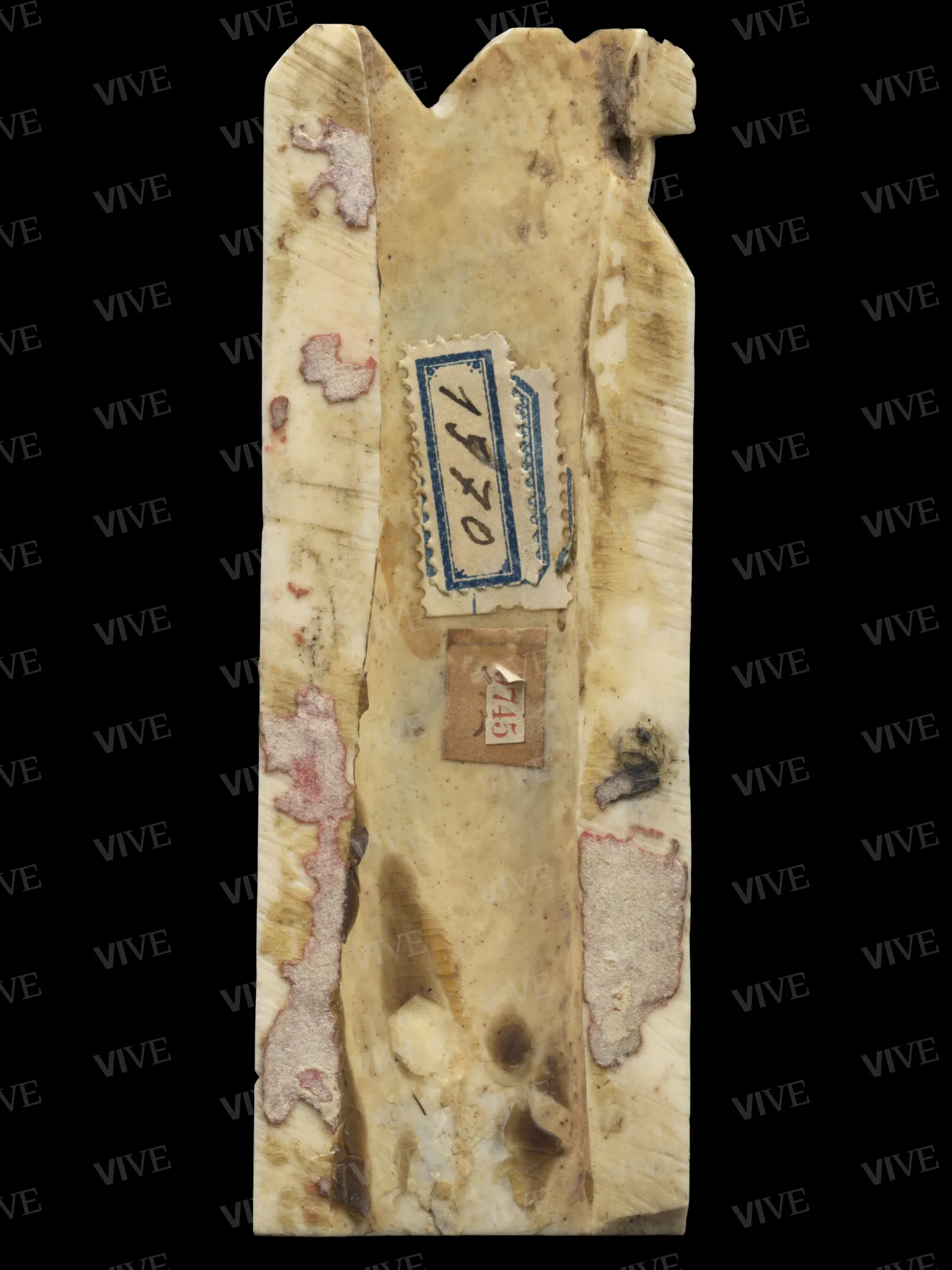Plaque from a casket set with stories from Susanna: Susanna bathing
Workshop of Baldassarre Ubriachi Late-14th century
On a single bone strip is depicted a naked maiden, her hair up, head turned to the left, and arms bent and stretched out in the opposite direction. She is depicted in the act of running from a circular pool in which her legs alone are still immersed. The presence of water is rendered through repeated winding segments in different thicknesses. In the background a hilly landscape is enlivened by four small trees with umbrella-type foliage. The plaque has a molded graft at the base, with the number three in red ink.
On a single bone strip is depicted a naked maiden, her hair up, head turned to the left, and arms bent and stretched out in the opposite direction. She is depicted in the act of running from a circular pool in which her legs alone are still immersed. The presence of water is rendered through repeated winding segments in different thicknesses. In the background a hilly landscape is enlivened by four small trees with umbrella-type foliage. The plaque has a molded graft at the base, with the number three in red ink.
Details of work
Catalog entry
The uncertain availability of elephant ivory in the West during the Middle Ages prompted workers active in its manufacture to use more readily available and less expensive raw materials to meet demands during shortages. In the second half of the fourteenth century, in central and northern Italy, the bone of animals such as oxen, horses, and pigs was regularly used to make precious artifacts. In an attempt to take full advantage of its spatial possibilities, individual bone segments, once carved and polished, were placed alongside one another and fixed onto a wooden support. This procedure made it possible to create authentically figurative cycles, both in larger artifacts such as triptychs and caskets, and in smaller ones such as coffers and altarpieces. The fragment presented here, which is of exceptional quality, best illustrates this modular procedure that became typical of the workshop that, first in Florence and then in Venice, was founded by the Florentine merchant Baldassarre Ubriachi or Embriachi and was headed by the “master of bonework” Giovanni di Jacopo (Schlosser 1899; Merlini 1989; Tomasi 2016a; Chiesi 2018). This small plaque, due to its courtly, refined style, can be compared with the carvings that make up the (now dismembered) triptych and caskets that, around the year 1400, were made at the behest of the duke of Milan Gian Galeazzo Visconti for the Carthusian monastery in Pavia and are considered the masterpieces of Embriachi production. The lack of molding at the top would suggest that it was originally part of a scene framed by an arch resting on small columns, as can be seen in other caskets datable to between the late fourteenth and very early fifteenth centuries. However, it is certain that the number “three” traced in ink on the base served to indicate its proper placement on the outside of a casket or, alternatively, on a panel. The iconography relates to the biblical stories of Susanna and the Elders and specifically the bathing scene when Joakim's daughter was surprised by two elderly judges of the people—the two old men—who then threatened and blackmailed her (from the Catholic Old Testament, Daniel 13, 1–64). As Michele Tomasi has argued, this theme is rare in early Embriachi production (Tomasi 2016b), and only a few examples dealing with this episode are known. A scene with Susanna bathing as she is being spied on by the elders is depicted in a fragmentary panel now in the Musée des Arts Décoratifs in Paris (Tomasi 2010, pp. 266–279, 427, fig. 58). Just as in the Roman fragment, here, too, Susanna, with her hair up, is depicted in a basin carved from a rock, in contrast to later depictions where the scene is set in an actual carved basin. Another significant parallel for the Roman plaque is offered by a casket in the Camillo Leoni museum in Vercelli (Saroni 2012/2013). Although in the Vercelli casket Susanna is depicted when she is already out of the water and about to flee, she has been given the same pose as that of the Palazzo Venezia bone carving, thus implying the use of the same model. The same pattern was repeated by the workshop for its depiction of Thisbe fleeing from the lioness in one of the scenes originally part of the coffers of the Carthusian monastery in Pavia, now reassembled on a panel in the Metropolitan Museum of Art in New York (Wyman 1936). These other examples, therefore, make it possible for the Roman bone carving to be dated to about the end of the fourteenth century in the context of the early activity of workshop of Baldassarre Ubriachi.
Giampaolo Distefano
Entry published on 12 February 2025
State of conservation
Good.
Inscriptions
In ink at the base is the number “three” in Arabic numerals.
References
von Schlosser Julius, Die Werkstatt der Embriachi in Venedig, in «Jahrbuch der Kunsthistorischen Sammlungen des Allerhöchsten Kaiserhauses», 20, 1899, pp. 220-282;
Giorgio Bernardini, Il nuovo Museo di Palazzo Venezia. Arte Bizantina - Oggetti in osso e in avorio, in «Rassegna d’arte», XVII, 1917, pp. 25-44 (p. 40);
Wyman Alice Mary, The Helyas Legend as Represented on the Embriachi Ivories at the Metropolitan Museum of Art, in «The Art Bulletin», XVIII, 1936, pp. 5-24;
Merlini Elena, La “Bottega degli Embriachi” e i cofanetti eburnei fra Trecento e Quattrocento: una proposta di classificazione, in «Arte cristiana», 76, 1989, pp. 267-282;
Tomasi Michele, Miti antichi e riti nuziali: sull’iconografia e la funzione dei cofanetti degli Embriachi, in «Iconographica», 2, 2003, pp. 126-145;
Tomasi Michele, Monumenti d’avorio. I dossali degli Embriachi e i loro committenti, Pisa 2010;
Saroni Giovanna, Nuove segnalazioni di opere in avorio tra il Piemonte e la Savoia, in «Palazzo Madama. Studi e notizie», 3, 2012-2013, pp. 168-177, n. 2;
Tomasi Michele, La bottega degli Embriachi e gli oggetti in legno e osso in Italia fra Tre e Quattrocento, in Castronovo Simonetta, Crivello Fabrizio, Tomasi Michele (a cura di), Avori medievali. Collezioni del Museo Civico d’Arte Antica di Torino, Savigliano 2016, pp. 151-153 (Tomasi 2016a);
Tomasi Michele, in Castronovo Simonetta, Crivello Fabrizio, Tomasi Michele (a cura di), Avori medievali. Collezioni del Museo Civico d’Arte Antica di Torino, Savigliano 2016, pp. 164-167, n. 31 (Tomasi 2016b);
Chiesi Benedetta, Gli Embriachi e le botteghe dell’Italia settentrionale fra Tre e Quattrocento, in Ciseri Ilaria (a cura di), Gli avori del Museo Nazionale del Bargello, Milano 2018, pp. 334-335.

